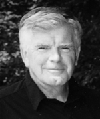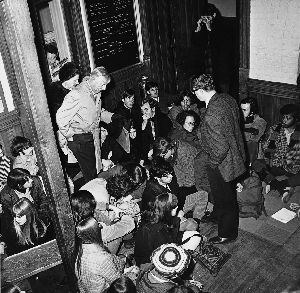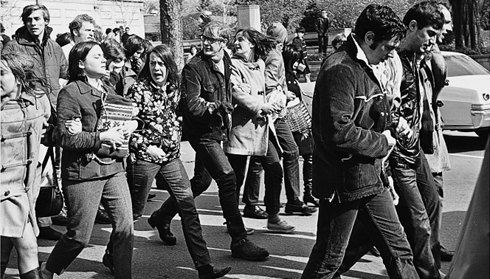Historian's Notebook

By Geoffrey Blodgett '53
Photographs courtesy of Oberlin College Archives
While roaming recently through five decades of campus memories, I had no trouble choosing the most searing of them-the day the Kent State murder report arrived in Oberlin on May 4, 1970. There had been plenty of angry local moments in the Viet Nam War protest before Kent State. The Finney Chapel draft test blockade in May 1966. The capture of the Navy recruiter in his car on North Main Street in October 1967. The Peters sit-in against Marine recruiters while a Viet Cong flag flapped on Tappan Square in February 1969. The guerrilla theater classroom disruptions protesting a campus visit by Peace Corps recruiters in March 1969. But Kent State was different. Psychologically it brought the possibility of official violence against war protesters to every campus in America.
A few years ago I sat on the floor of a Seattle living room with a batch of Oberlin alumni from the late '60s and early '70s. Their testimony was that Kent State was the turning point. Till then everything seemed possible. The protests had been working, and the hopeful idealism of the mid-'60s was intact.

RIGHT: President and Mrs. Carr make their way through a 1969 sit-in in Peters Hall
Oberlin political scientist Jere Bruner, who joined the faculty in 1967, captured the mood in a brilliant talk for the 25th reunion of the class of 1963. Here is a bit of what he said: "Many of us were caught up in revolutionary enthusiasm. We lived in expectation that what before had not been possible was somehow now about to happen. The incantatory words! Peace would come. Change. Relevance. America would be greening. The age of Aquarius was before us...We would make love, not war. Classical structure would fall before the assaults of moralistic militance, which would give way to romantic self-actualization. Training from without would yield to unfolding from within. The kingdom would come."
Then students began to be killed, at Kent and elsewhere, and the Movement snapped.
I was a little older than Jere. I never thought I knew what was going to happen next in the 1960s. One of my early students was Rennie Davis, later famous among the Chicago Seven. One day in my office we talked about democratic possibilities. In my 1950s wisdom I suggested that he read Reinhold Niebuhr on democracy. Instead he went off to help Tom Hayden organize Students for a Democratic Society. I was blindsided by the likes of Rennie Davis and by the war and by all the protest. I did learn a lot from my fellow historian Ron Suny, the main faculty mentor to Oberlin protesters after his arrival in 1968. Ron's guidance of the campus left through the Kent State crisis was crucial in curbing a disruptive local backlash against the murders. In contrast to Ron and Jere I was mostly a puzzled observer.
On the night of the murders Finney Chapel filled for an angry protest. Since I wondered what was going to happen next, I went to the Chapel and stood by the back wall to listen. The rhetoric was as passionately revolutionary as any I had ever heard, and the shouted responses were loud and hot. Then an eyewitness from Kent State was brought to the stage to tell what he had seen. I remember his concluding words exactly: "If you want to make a revolution, you've got to be prepared to die." After that you could have heard a pin drop.

Students march to city hall following a 1967 demonstration against U.S. Navy recruiters.
The war and various student protests against it, increasingly stylized and media-tuned, continued. But I think that for Oberlin at least, something ended that night in Finney. Talk of revolution was still on the tongue, but it seemed less firm in its conviction.
Meanwhile the faculty debated whether to take an "institutional stand" against the war. Campus polls showed that an overwhelming majority of faculty and students opposed the war, but many professors, along with President Carr, mistrusted a formal stand as a cramp on freedom of inquiry. Others felt such a stand would be merely symbolic. To this latter objection a student spokesman, freshman Lee Fisher, made an apt reply. While a resolution against the war might well be symbolic, he said, the faculty should not reject one symbol in favor of another-the ivory tower-but should decide which was more important. In the end an anti-war resolution passed with the understanding that each faculty member could sign on or not as he or she decided.
The day after the shootings Oberlin suspended its normal aca-demic year. A "Liberation College" of lectures, debates, and organizing committees used the time before commencement to condemn the war and study its origins. Meanwhile 250 students led by the Conservatory's Robert Fountain went to Washington to perform Mozart's Requiem in Washington Cathedral. Graduating seniors voted not to wear caps and gowns to their commencement, which was a brief and solemn ceremony addressed by Jesse Jackson. It was Bob Carr's last public appearance as college president. At the end of the summer Bobby Fuller succeeded him. A new era in Oberlin history began, and we all wondered what was going to happen next.
Historian's Notebook is a new column that will reflect upon parts of Oberlin College history. GEOFFREY BLODGETT is the Danforth Professor of History at Oberlin.